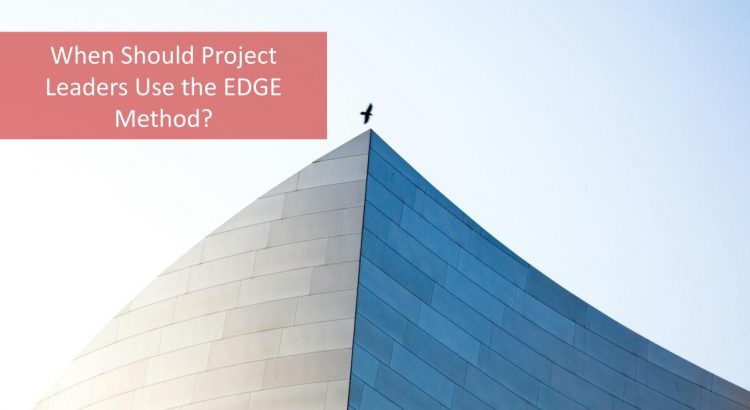Project leadership is as much an art as it is a science. Leaders must balance teaching, coaching, mentoring, and empowering their teams while navigating complex project environments. One proven approach that bridges these needs is the EDGE method—Explain, Demonstrate, Guide, and Enable. But when should project leaders use it? And how can it make the difference between a struggling project team and a thriving one?
Let’s explore.
When Project Leaders Should Use the WOOP Method?
The EDGE Method at a Glance
The EDGE method is a four-step instructional and leadership approach designed to build capability and confidence in individuals or teams:
- Explain – Introduce the task, process, or concept clearly and thoroughly.
- Demonstrate – Show how it’s done in real time, modeling the behavior or method.
- Guide – Allow the individual or team to try, while providing feedback and support.
- Enable – Step back, granting autonomy once the team demonstrates competence.
This approach works especially well in environments where leaders must train, transition, or inspire individuals to handle responsibility independently.
Boosting Project Team Morale and Motivation: Proven Techniques for Keeping Your Team Engaged
When to Use the EDGE Method
1. During Onboarding or Team Formation
When new team members join a project, they’re often navigating not just tasks but also culture, systems, and expectations. A project leader can Explain company processes, Demonstrate tools like Microsoft Project or Jira, Guide them through their first sprint planning session, and then Enable them to run their own tasks confidently.
Example:
In the pharmaceutical industry, where compliance and precision are vital, onboarding a new analyst into regulatory submission processes requires careful guidance. Using the EDGE method ensures accuracy without overwhelming the new hire.
Exceptional Companies Hire for Values First, Aptitude Second, and Skills Third: Here’s Why
2. When Introducing New Tools or Methodologies
Project managers often lead teams through transitions—shifting from waterfall to Agile, implementing new collaboration software, or adopting AI-driven analytics. The EDGE method smooths these changes.
Example:
A financial services project leader rolling out Agile ceremonies for the first time can:
- Explain backlog refinement and sprint planning.
- Demonstrate a live sprint retrospective.
- Guide the team in running their own retrospective.
- Enable them to fully own the Agile process within three to four cycles.
This builds not just competence, but ownership.
3. In High-Stakes, Safety-Critical Environments
Where mistakes can have major consequences, project leaders cannot rely on vague instructions. The EDGE method ensures thorough training and readiness.
Example:
In aviation engineering projects, introducing technicians to new maintenance procedures demands clarity. Leaders Explain the step-by-step safety checks, Demonstrate on aircraft components, Guide the team while shadowing their attempts, and finally Enable them to execute independently with accountability.
Good vs. Wise Decisions in Project Management: The Subtle Difference That Shapes Outcomes
4. When Scaling Leadership Across Levels
EDGE is not just for training junior team members. It’s equally effective when project leaders are mentoring rising leaders in the organization.
Example:
In a construction megaproject, a senior project manager mentoring a site manager can use EDGE to transfer responsibility for stakeholder meetings. They first Explain how to communicate scope and cost trade-offs, Demonstrate a meeting with municipal officials, Guide the site manager through role-play and real discussions, and finally Enable them to run stakeholder sessions solo.
The Ripple Effect: How Exceptional Leaders Turn Personal Wins into Shared Victories
5. For Cross-Functional Collaboration
Projects often bring together people from different departments with diverse backgrounds. The EDGE method helps establish a common ground of practice and understanding.
Example:
In a global consumer technology project, marketing, design, and engineering teams may clash over priorities. A project leader can use EDGE to align them on the product roadmap process: Explain the framework, Demonstrate integrated planning, Guide them through collaboration, and Enable cross-functional ownership of deliverables.
Understanding Hype Cycles as a Project Manager: When to Ride the Wave and When to Step Back
Why EDGE Works
- Builds Confidence: It replaces ambiguity with structured learning.
- Reduces Errors: Demonstration and guided practice reduce costly mistakes.
- Fosters Autonomy: Teams progress from dependence on the leader to independent execution.
- Scales Expertise: Leaders replicate their knowledge across multiple people or teams, ensuring continuity.
Final Thoughts
Project leadership is not about doing everything yourself; it’s about enabling others to succeed. The EDGE method provides a structured, flexible way for leaders to teach, coach, and transfer ownership.
Whether you’re leading a high-stakes aerospace project, guiding a fintech team through Agile adoption, or mentoring new managers in construction, the EDGE method ensures your people are not just following instructions but developing the competence and confidence to lead themselves.
Embracing the Beginner’s Mindset as a Project Leader: Why It Matters and How to Maintain It
The best project leaders know when to step forward to explain and demonstrate, when to stand beside their team to guide, and when to step back to enable true ownership. That’s the essence of EDGE—and the essence of lasting project success.
Check out our Program and Project Leadership Training that helps organizations develop their project executives tailored to their organizations.
